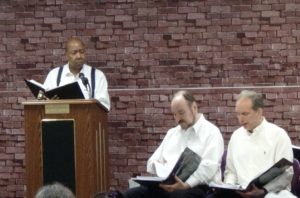The Triangle Fire, an opera reviewed by Jonathan Dzik
Comments Off on The Triangle Fire, an opera reviewed by Jonathan DzikApril 2, 2017 by Admin
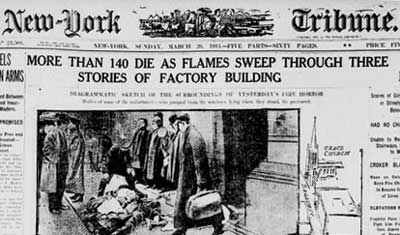
The Triangle Fire
Music: Leonard Lehrman Libretto: Ellen Frankel
At the HBO Theater (1100 6th Ave.)
Thursday, March 23, 2017
by Jonathan Dzik
Performance photos by Helene Williams
 Real events, historical and often tragic, have lent themselves to operatic treatment. The rebellion of the Sicilians in 1283, which Verdi set to I Verspri Siciliani, the lead-up to the testing of the atomic bomb in New Mexico in the 1940s—Dr. Atomic—by John Adams, and The Death of Klinghoffer—based on an incident on the Achille Lauro cruise ship in 1985 where a wheelchair bound Jewish passenger was murdered by a Palestinian and thrown overboard—by the same composer, are examples of such settings. More recently, The Triangle Fire, Leonard Lehrman’s 11th opera and his first collaboration with librettist Ellen Frankel is a recent addition to this genre. This 70-minute one-act opera tells the story of the infamous Triangle Shirt-Waist fire which occurred on March 25, 1911 and caused the death of 146 garment workers (129 women and 17 men).
Real events, historical and often tragic, have lent themselves to operatic treatment. The rebellion of the Sicilians in 1283, which Verdi set to I Verspri Siciliani, the lead-up to the testing of the atomic bomb in New Mexico in the 1940s—Dr. Atomic—by John Adams, and The Death of Klinghoffer—based on an incident on the Achille Lauro cruise ship in 1985 where a wheelchair bound Jewish passenger was murdered by a Palestinian and thrown overboard—by the same composer, are examples of such settings. More recently, The Triangle Fire, Leonard Lehrman’s 11th opera and his first collaboration with librettist Ellen Frankel is a recent addition to this genre. This 70-minute one-act opera tells the story of the infamous Triangle Shirt-Waist fire which occurred on March 25, 1911 and caused the death of 146 garment workers (129 women and 17 men).
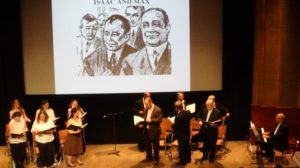 Accompanied by Dr, Lehrman on an electric keyboard, 12 members (6 men and 6 women) of the Metropolitan Philharmonic Chorus gave a vivid account of this horrific event. Unique in this presentation was the fact that, as in ancient Greek theater, each of the 12 members of the chorus stepped out of their chorus roles to become specific characters and soloists in the telling of this story. The libretto by Ellen Frankel was based on 2,000 pages of transcript from the trial of the owners of the factory which took place 9 months after the fire. With a prologue, 4 scenes and 2 brief epilogues, the account of the events of this fire—recalled mostly in the trial of those deemed responsible—was a gripping 70 minutes of seamless continuity which riveted the listener to the gravity and enormity of this event.
Accompanied by Dr, Lehrman on an electric keyboard, 12 members (6 men and 6 women) of the Metropolitan Philharmonic Chorus gave a vivid account of this horrific event. Unique in this presentation was the fact that, as in ancient Greek theater, each of the 12 members of the chorus stepped out of their chorus roles to become specific characters and soloists in the telling of this story. The libretto by Ellen Frankel was based on 2,000 pages of transcript from the trial of the owners of the factory which took place 9 months after the fire. With a prologue, 4 scenes and 2 brief epilogues, the account of the events of this fire—recalled mostly in the trial of those deemed responsible—was a gripping 70 minutes of seamless continuity which riveted the listener to the gravity and enormity of this event.
The basic facts of the fire are that on the afternoon of Saturday, March 25, 1911, a fire broke out on the 8th floor of the Triangle Shirt-Waist building in lower Manhattan and quickly spread to the 9th and 10th floors as well. Most of the victims either burned to death or leapt to their deaths because there was no escape. The exit doors were locked to prevent theft by the workers, and the elevator operated for only a few minutes. The two co-owners of the factory—Max Blanck and Isaac Harris—were brought to trial in December of the same year. Most of the victims were young Jewish and Italian women who worked in sweatshop conditions with the most minimal of wages. Virtually all of the workers were recent immigrants with poor English skills.
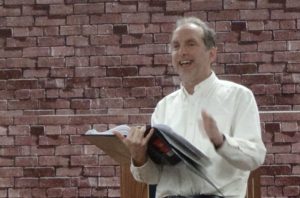 In his program notes, Dr. Lehrman indicates that similar to Wagner with his leitmotifs, he used different meters to portray different characters. For example, the music of the defense attorney, slickly played by Max David Steuer (at left), is portrayed in a quick 6/8 meter. The prosecuting attorney, David Anchel (bass) is given a series of irregular and unusual meters—5/4, 5/8 and 15/8. Lehrman uses the intervals of an octave, 9th and 10th to depict events on those floors. Lehrman’s underscore of the vocal lines and his keyboard accompaniments were impeccably balanced to highlight the vocal telling of the story
In his program notes, Dr. Lehrman indicates that similar to Wagner with his leitmotifs, he used different meters to portray different characters. For example, the music of the defense attorney, slickly played by Max David Steuer (at left), is portrayed in a quick 6/8 meter. The prosecuting attorney, David Anchel (bass) is given a series of irregular and unusual meters—5/4, 5/8 and 15/8. Lehrman uses the intervals of an octave, 9th and 10th to depict events on those floors. Lehrman’s underscore of the vocal lines and his keyboard accompaniments were impeccably balanced to highlight the vocal telling of the story
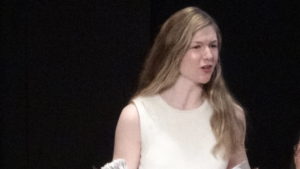 The opera opens with a prologue at a pier on the East River 5 days after the fire. In a haunting opening chorus, the rhetorical question is posed, “Who will speak for the dead?” The 12-member chorus, acting as a quasi-Greek chorus, set the somber mood for the telling of this tragedy. Stepping out of the chorus, the journalist, played by Bill Castleman, is given a jazzy, sauntering vocal line, partly sung and partly spoken. Canonical imitation in the chorus (men followed by the women) points out the universal reaction of grief and horror. Suddenly a voice, the ghost of one of the victims—Margaret Schwartz (dramatically portrayed by Perri Sussman – seen above)—distinguishes itself from the crowd. There is a brief poignant duet between her and a surviving witness Kate Alterman (Alessandra Altieri). The juxtaposition of the living and deceased characters was powerfully eerie and haunting.
The opera opens with a prologue at a pier on the East River 5 days after the fire. In a haunting opening chorus, the rhetorical question is posed, “Who will speak for the dead?” The 12-member chorus, acting as a quasi-Greek chorus, set the somber mood for the telling of this tragedy. Stepping out of the chorus, the journalist, played by Bill Castleman, is given a jazzy, sauntering vocal line, partly sung and partly spoken. Canonical imitation in the chorus (men followed by the women) points out the universal reaction of grief and horror. Suddenly a voice, the ghost of one of the victims—Margaret Schwartz (dramatically portrayed by Perri Sussman – seen above)—distinguishes itself from the crowd. There is a brief poignant duet between her and a surviving witness Kate Alterman (Alessandra Altieri). The juxtaposition of the living and deceased characters was powerfully eerie and haunting.
It was natural to blame the two owners of the factory for locking the exits, hence their trial months later. This trial takes up the bulk of the rest of the opera. Both the prosecuting attorney (Charles Bostwick, played by stentorian bass David Anchel) and the defense attorney (Max David Steuer, played by character tenor Thomas Smith) extoll their own virtues before getting down to the actual trial. Judge Thomas Crain is given basic four-square music, as befitting his position of power, and was solidly performed by Charles Samuel Brown. His frequent gavel-pounding was carefully timed to specific beats in the accompaniment. One of the lines given to the judge was particularly apropos to some of the events of today: “They’ll (immigrants) soon outnumber us real Americans.” In a brief moment of diversion, when some of the workers were trying to leave the burning factory, were humming a tune from a Broadway Show of the day (Madame Sherry), Lehrman actually quotes a brief vignette from that show.
In broken English, Kate Alterman (Alessandra Altieri) gives an emotional testimony to what she saw happened on the day of the fire. The defense attorney makes her repeat her testimony a few times. She repeats it verbatim, suggesting to the jury that she might have been coached and hence memorized her statements.
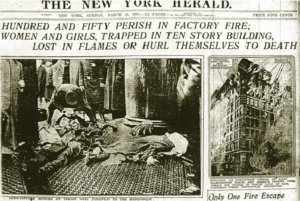 In a brief flashback to the day of the fire, the owners describe how they tried to help victims escape to the roof and succeeded in saving a few. A dramatic bit of staging showed how 4 girls ended up blocked by a locked door. The verbal description of those who jumped to their death rather than burn—“Thud-dead”—repeated over and over, was chilling. Dissonant chords at the word “Fire” emphasized the gravity of the moment.
In a brief flashback to the day of the fire, the owners describe how they tried to help victims escape to the roof and succeeded in saving a few. A dramatic bit of staging showed how 4 girls ended up blocked by a locked door. The verbal description of those who jumped to their death rather than burn—“Thud-dead”—repeated over and over, was chilling. Dissonant chords at the word “Fire” emphasized the gravity of the moment.
As the two owners were called as witnesses by the defense attorney, they sang a paean to shirt-waists in harmonious 3rds and 6ths, giving confidence to their contention that they were not at fault.
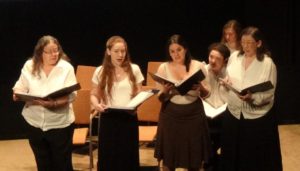 Anyone who was not a soloist at a given moment was part of the chorus, often echoing the key words of the witnesses for emphasis. The chorus was impeccably in tune with often jagged intervals and dissonant harmonies to sing.
Anyone who was not a soloist at a given moment was part of the chorus, often echoing the key words of the witnesses for emphasis. The chorus was impeccably in tune with often jagged intervals and dissonant harmonies to sing.
In a cameo appearance, Lehrman, as jury foreman, gives out with the verdict, with a dramatic pregnant pause, heightening the suspense…NOT GUILTY! Max’s 2 daughters Mildred and Henrietta (played by Michelle Pelegrino and Jackie Bakewell) rejoice that their fathers are cleared of blame.
In an important and necessary epilogue, it was described that even though the owners were found not guilty, new laws were passed for fire safety in factories and the formation of the National Labor Relations Board. Portraying the journalist’s great-granddaughter (Sarah Shepherd Ashton) Bakewell, in the first epilogue stepped forward in a solo saying that the story doesn’t end here in the courtroom. This kind of event should not ever happen again, but it did, as described in the second epilogue. She exhibited impeccable diction and musicality in her rendition.
In a second epilogue, depicting the events of an even more horrendous fire in Bangladesh just 4 years ago, with a much greater loss of life, the chorus has the final word—a kind of editorial set of rhetorical questions: “Who will speak for our silent dead? Who will unlock that door?”
Although the text of the libretto (along with some key pictures) were projected on a large screen, the articulate diction of all of the performers made that unnecessary. Every word could be clearly understood. It was a gripping, riveting performance by all 12 of the performers led masterfully by the composer at the keyboard.

Category Sight, Sound, Word | Tags:
Comments Off on The Triangle Fire, an opera reviewed by Jonathan Dzik
Sorry, comments are closed.

